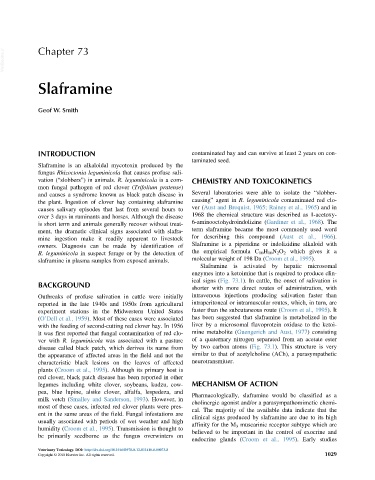Page 1097 - Veterinary Toxicology, Basic and Clinical Principles, 3rd Edition
P. 1097
VetBooks.ir Chapter 73
Slaframine
Geof W. Smith
INTRODUCTION contaminated hay and can survive at least 2 years on con-
taminated seed.
Slaframine is an alkaloidal mycotoxin produced by the
fungus Rhizoctonia leguminicola that causes profuse sali-
vation (“slobbers”) in animals. R. leguminicola is a com- CHEMISTRY AND TOXICOKINETICS
mon fungal pathogen of red clover (Trifolium pratense)
and causes a syndrome known as black patch disease in Several laboratories were able to isolate the “slobber-
the plant. Ingestion of clover hay containing slaframine causing” agent in R. leguminicola contaminated red clo-
ver (Aust and Broquist, 1965; Rainey et al., 1965) and in
causes salivary episodes that last from several hours to
1968 the chemical structure was described as 1-acetoxy-
over 3 days in ruminants and horses. Although the disease
6-aminooctohydroindolizine (Gardiner et al., 1968). The
is short term and animals generally recover without treat-
term slaframine became the most commonly used word
ment, the dramatic clinical signs associated with slafra-
mine ingestion make it readily apparent to livestock for describing this compound (Aust et al., 1966).
owners. Diagnosis can be made by identification of Slaframine is a piperidine or indolizidine alkaloid with
R. leguminicola in suspect forage or by the detection of the empirical formula C 10 H 10 N 2 O 2 which gives it a
slaframine in plasma samples from exposed animals. molecular weight of 198 Da (Croom et al., 1995).
Slaframine is activated by hepatic microsomal
enzymes into a ketoimine that is required to produce clin-
ical signs (Fig. 73.1). In cattle, the onset of salivation is
BACKGROUND
shorter with more direct routes of administration, with
Outbreaks of profuse salivation in cattle were initially intravenous injections producing salivation faster than
reported in the late 1940s and 1950s from agricultural intraperitoneal or intramuscular routes, which, in turn, are
experiment stations in the Midwestern United States faster than the subcutaneous route (Croom et al., 1995). It
(O’Dell et al., 1959). Most of these cases were associated has been suggested that slaframine is metabolized in the
with the feeding of second-cutting red clover hay. In 1956 liver by a microsomal flavoprotein oxidase to the ketoi-
it was first reported that fungal contamination of red clo- mine metabolite (Guengerich and Aust, 1977) consisting
ver with R. leguminicola was associated with a pasture of a quaternary nitrogen separated from an acetate ester
disease called black patch, which derives its name from by two carbon atoms (Fig. 73.1). This structure is very
the appearance of affected areas in the field and not the similar to that of acetylcholine (ACh), a parasympathetic
characteristic black lesions on the leaves of affected neurotransmitter.
plants (Croom et al., 1995). Although its primary host is
red clover, black patch disease has been reported in other
legumes including white clover, soybeans, kudzu, cow- MECHANISM OF ACTION
pea, blue lupine, alsike clover, alfalfa, lespedeza, and
Pharmacologically, slaframine would be classified as a
milk vetch (Smalley and Sanderson, 1993). However, in
cholinergic agonist and/or a parasympathomimetic chemi-
most of these cases, infected red clover plants were pres-
cal. The majority of the available data indicate that the
ent in the same areas of the field. Fungal infestations are
clinical signs produced by slaframine are due to its high
usually associated with periods of wet weather and high
affinity for the M 3 muscarinic receptor subtype which are
humidity (Croom et al., 1995). Transmission is thought to
believed to be important in the control of exocrine and
be primarily seedborne as the fungus overwinters on
endocrine glands (Croom et al., 1995). Early studies
Veterinary Toxicology. DOI: http://dx.doi.org/10.1016/B978-0-12-811410-0.00073-8
Copyright © 2018 Elsevier Inc. All rights reserved. 1029

